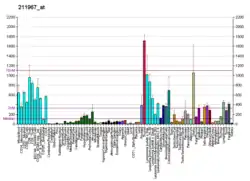TMEM123
Porimin is a protein that in humans is encoded by the TMEM123 gene.[5][6]
| TMEM123 | |||||||||||||||||||||||||||||||||||||||||||||||||||
|---|---|---|---|---|---|---|---|---|---|---|---|---|---|---|---|---|---|---|---|---|---|---|---|---|---|---|---|---|---|---|---|---|---|---|---|---|---|---|---|---|---|---|---|---|---|---|---|---|---|---|---|
| Identifiers | |||||||||||||||||||||||||||||||||||||||||||||||||||
| Aliases | TMEM123, KCT3, PORIMIN, PORMIN, transmembrane protein 123 | ||||||||||||||||||||||||||||||||||||||||||||||||||
| External IDs | OMIM: 606356 MGI: 1919179 HomoloGene: 14177 GeneCards: TMEM123 | ||||||||||||||||||||||||||||||||||||||||||||||||||
| |||||||||||||||||||||||||||||||||||||||||||||||||||
| |||||||||||||||||||||||||||||||||||||||||||||||||||
| |||||||||||||||||||||||||||||||||||||||||||||||||||
| |||||||||||||||||||||||||||||||||||||||||||||||||||
| |||||||||||||||||||||||||||||||||||||||||||||||||||
| Wikidata | |||||||||||||||||||||||||||||||||||||||||||||||||||
| |||||||||||||||||||||||||||||||||||||||||||||||||||
This gene encodes a highly glycosylated transmembrane protein with a high content of threonine and serine residues in its extracellular domain, similar to a broadly defined category of proteins termed mucins.
Exposure of some cell types to anti-PORIMIN (pro-oncosis receptor inducing membrane injury) antibody, crosslinks this protein on the cell surface and induces a type of cell death termed oncosis.
Oncosis is distinct from apoptosis and is characterized by a loss of cell membrane integrity without DNA fragmentation. This gene product is proposed to function as a cell surface receptor that mediates cell death.[6]
References
- GRCh38: Ensembl release 89: ENSG00000152558 - Ensembl, May 2017
- GRCm38: Ensembl release 89: ENSMUSG00000050912 - Ensembl, May 2017
- "Human PubMed Reference:". National Center for Biotechnology Information, U.S. National Library of Medicine.
- "Mouse PubMed Reference:". National Center for Biotechnology Information, U.S. National Library of Medicine.
- Ma F, Zhang C, Prasad KV, Freeman GJ, Schlossman SF (Aug 2001). "Molecular cloning of Porimin, a novel cell surface receptor mediating oncotic cell death". Proc Natl Acad Sci U S A. 98 (17): 9778–83. Bibcode:2001PNAS...98.9778M. doi:10.1073/pnas.171322898. PMC 55529. PMID 11481458.
- "Entrez Gene: TMEM123 transmembrane protein 123".
Further reading
- Dekker J, Rossen JW, Büller HA, Einerhand AW (2002). "The MUC family: an obituary". Trends Biochem. Sci. 27 (3): 126–31. doi:10.1016/S0968-0004(01)02052-7. PMID 11893509.
- Maruyama K, Sugano S (1994). "Oligo-capping: a simple method to replace the cap structure of eukaryotic mRNAs with oligoribonucleotides". Gene. 138 (1–2): 171–4. doi:10.1016/0378-1119(94)90802-8. PMID 8125298.
- Suzuki Y, Yoshitomo-Nakagawa K, Maruyama K, et al. (1997). "Construction and characterization of a full length-enriched and a 5'-end-enriched cDNA library". Gene. 200 (1–2): 149–56. doi:10.1016/S0378-1119(97)00411-3. PMID 9373149.
- Zhang C, Xu Y, Gu J, Schlossman SF (1998). "A cell surface receptor defined by a mAb mediates a unique type of cell death similar to oncosis". Proc. Natl. Acad. Sci. U.S.A. 95 (11): 6290–5. Bibcode:1998PNAS...95.6290Z. doi:10.1073/pnas.95.11.6290. PMC 27661. PMID 9600958.
- Strausberg RL, Feingold EA, Grouse LH, et al. (2003). "Generation and initial analysis of more than 15,000 full-length human and mouse cDNA sequences". Proc. Natl. Acad. Sci. U.S.A. 99 (26): 16899–903. Bibcode:2002PNAS...9916899M. doi:10.1073/pnas.242603899. PMC 139241. PMID 12477932.
- Bonkobara M, Das A, Takao J, et al. (2003). "Identification of novel genes for secreted and membrane-anchored proteins in human keratinocytes". Br. J. Dermatol. 148 (4): 654–64. doi:10.1046/j.1365-2133.2003.05244.x. PMID 12752121. S2CID 21635573.
- Clark HF, Gurney AL, Abaya E, et al. (2003). "The secreted protein discovery initiative (SPDI), a large-scale effort to identify novel human secreted and transmembrane proteins: a bioinformatics assessment". Genome Res. 13 (10): 2265–70. doi:10.1101/gr.1293003. PMC 403697. PMID 12975309.
- Zhang Z, Henzel WJ (2005). "Signal peptide prediction based on analysis of experimentally verified cleavage sites". Protein Sci. 13 (10): 2819–24. doi:10.1110/ps.04682504. PMC 2286551. PMID 15340161.
- Gerhard DS, Wagner L, Feingold EA, et al. (2004). "The status, quality, and expansion of the NIH full-length cDNA project: the Mammalian Gene Collection (MGC)". Genome Res. 14 (10B): 2121–7. doi:10.1101/gr.2596504. PMC 528928. PMID 15489334.
- Rual JF, Venkatesan K, Hao T, et al. (2005). "Towards a proteome-scale map of the human protein-protein interaction network". Nature. 437 (7062): 1173–8. Bibcode:2005Natur.437.1173R. doi:10.1038/nature04209. PMID 16189514. S2CID 4427026.
- Otsuki T, Ota T, Nishikawa T, et al. (2007). "Signal sequence and keyword trap in silico for selection of full-length human cDNAs encoding secretion or membrane proteins from oligo-capped cDNA libraries". DNA Res. 12 (2): 117–26. doi:10.1093/dnares/12.2.117. PMID 16303743.
- Kimura K, Wakamatsu A, Suzuki Y, et al. (2006). "Diversification of transcriptional modulation: large-scale identification and characterization of putative alternative promoters of human genes". Genome Res. 16 (1): 55–65. doi:10.1101/gr.4039406. PMC 1356129. PMID 16344560.
This article is issued from Wikipedia. The text is licensed under Creative Commons - Attribution - Sharealike. Additional terms may apply for the media files.




